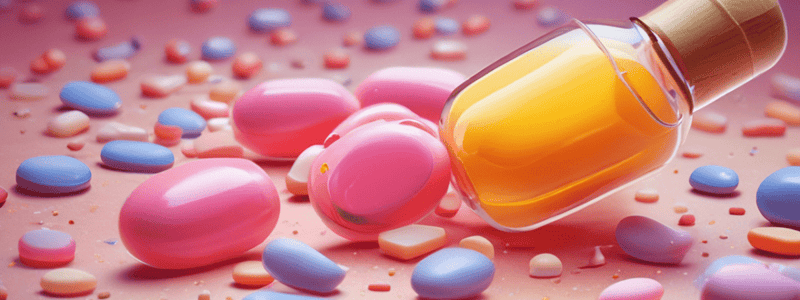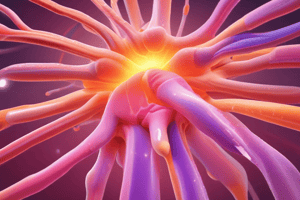Podcast
Questions and Answers
What is the primary mechanism of action of the drug described in the text?
What is the primary mechanism of action of the drug described in the text?
- Inhibition of COMT and MAO enzymes
- Stimulation of β1 and β2 adrenergic receptors (correct)
- Promotion of glycogenolysis and lipolysis
- Constriction of blood vessels in the ciliary body
Which of the following is NOT a reported use of the drug?
Which of the following is NOT a reported use of the drug?
- Alleviation of dyspnea in asthma
- Reduction of intraocular pressure in glaucoma
- Management of cardiac arrest (correct)
- Treatment of bronchospasm
What is the effect of the drug on glycemia?
What is the effect of the drug on glycemia?
- Decrease in glycogenolysis and glucagon release
- Decrease in glycogenolysis and insulin release
- Increase in glycogenolysis and glucagon release (correct)
- Increase in glycogenolysis and insulin release
Which of the following adverse effects of the drug is NOT mentioned in the text?
Which of the following adverse effects of the drug is NOT mentioned in the text?
What is the significance of the drug's metabolism by COMT and MAO?
What is the significance of the drug's metabolism by COMT and MAO?
How does the drug interact with β-blockers?
How does the drug interact with β-blockers?
What is the rationale for the use of the drug in local anesthesia?
What is the rationale for the use of the drug in local anesthesia?
How do local anesthetic agents in C-Cocaine act in the synaptic space?
How do local anesthetic agents in C-Cocaine act in the synaptic space?
What is the effect of C-Cocaine on blood pressure?
What is the effect of C-Cocaine on blood pressure?
What distinguishes Ephedrine and Pseudoephedrine from catecholamines in terms of metabolic processing?
What distinguishes Ephedrine and Pseudoephedrine from catecholamines in terms of metabolic processing?
Which group of agonists causes the release of NE and activates adrenergic receptors on the postsynaptic membrane?
Which group of agonists causes the release of NE and activates adrenergic receptors on the postsynaptic membrane?
How are Ephedrine and Pseudoephedrine eliminated from the body?
How are Ephedrine and Pseudoephedrine eliminated from the body?
What makes Ephedrine and Pseudoephedrine different from catecholamines in terms of substrate specificity?
What makes Ephedrine and Pseudoephedrine different from catecholamines in terms of substrate specificity?
What differentiates Ephedrine from Pseudoephedrine regarding CNS effects?
What differentiates Ephedrine from Pseudoephedrine regarding CNS effects?
Which statement regarding colchicine use is incorrect?
Which statement regarding colchicine use is incorrect?
What is the recommended initial intravenous dose of colchicine for an acute gout attack?
What is the recommended initial intravenous dose of colchicine for an acute gout attack?
If a patient receives a full intravenous course of colchicine for an acute gout attack, how long should they avoid taking colchicine by any route?
If a patient receives a full intravenous course of colchicine for an acute gout attack, how long should they avoid taking colchicine by any route?
Which statement regarding the use of corticosteroids for acute gout attacks is correct?
Which statement regarding the use of corticosteroids for acute gout attacks is correct?
Which statement regarding the oral administration of colchicine for an acute gout attack is correct?
Which statement regarding the oral administration of colchicine for an acute gout attack is correct?
Which statement regarding the administration of colchicine is incorrect?
Which statement regarding the administration of colchicine is incorrect?
What is the maximum recommended total intravenous dose of colchicine for an acute gout attack?
What is the maximum recommended total intravenous dose of colchicine for an acute gout attack?
What is the primary mechanism of action of edrophonium?
What is the primary mechanism of action of edrophonium?
Which of the following is a potential adverse effect of excessive edrophonium administration?
Which of the following is a potential adverse effect of excessive edrophonium administration?
What is the antidote for cholinergic crisis induced by edrophonium overdose?
What is the antidote for cholinergic crisis induced by edrophonium overdose?
Which of the following drugs is structurally related to neostigmine and shares similar actions and side effects?
Which of the following drugs is structurally related to neostigmine and shares similar actions and side effects?
Which of the following is NOT a primary indication for the use of demecarium?
Which of the following is NOT a primary indication for the use of demecarium?
Which of the following drugs is the first cholinesterase inhibitor approved for the treatment of Alzheimer's disease?
Which of the following drugs is the first cholinesterase inhibitor approved for the treatment of Alzheimer's disease?
Which of the following is a common side effect associated with cholinesterase inhibitors used in the treatment of Alzheimer's disease?
Which of the following is a common side effect associated with cholinesterase inhibitors used in the treatment of Alzheimer's disease?
Which of the following statements regarding irreversible anticholinesterase compounds is NOT correct?
Which of the following statements regarding irreversible anticholinesterase compounds is NOT correct?
Which of the following statements about echothiophate is correct?
Which of the following statements about echothiophate is correct?
Which of the following statements regarding cholinesterase inhibitors used in the treatment of Alzheimer's disease is correct?
Which of the following statements regarding cholinesterase inhibitors used in the treatment of Alzheimer's disease is correct?
Which drug is the drug of choice for emergency lowering of IOP (intraocular pressure) in both open-angle and closed-angle glaucoma?
Which drug is the drug of choice for emergency lowering of IOP (intraocular pressure) in both open-angle and closed-angle glaucoma?
Which drug is used to promote salivation in xerostomia (dry mouth) resulting from head and neck radiation and Sjögren's syndrome?
Which drug is used to promote salivation in xerostomia (dry mouth) resulting from head and neck radiation and Sjögren's syndrome?
What is the primary mechanism of action of acetylcholinesterase inhibitors, such as those used to treat Alzheimer's disease?
What is the primary mechanism of action of acetylcholinesterase inhibitors, such as those used to treat Alzheimer's disease?
What is the primary therapeutic action of physostigmine in the body?
What is the primary therapeutic action of physostigmine in the body?
What is the duration of action of physostigmine?
What is the duration of action of physostigmine?
What is the primary side effect of pilocarpine that is related to its central nervous system (CNS) activity?
What is the primary side effect of pilocarpine that is related to its central nervous system (CNS) activity?
What is the mechanism of action of cevimeline, another non-specific cholinergic agent like pilocarpine?
What is the mechanism of action of cevimeline, another non-specific cholinergic agent like pilocarpine?
Flashcards are hidden until you start studying
Study Notes
Drug Mechanisms and Effects
- The drug's primary mechanism of action involves interaction with adrenergic receptors and modulating neurotransmitter release.
- Glycemia effects may include lowering blood sugar levels, depending on the drug's action and patient context.
- C-Cocaine acts in the synaptic space by inhibiting the reuptake of neurotransmitters, prolonging their effects.
Drug Uses and Interactions
- Reported uses of the drug include local anesthesia but may not encompass all potential applications.
- The drug interacts with β-blockers, potentially leading to altered cardiovascular responses.
- Local anesthetics like C-Cocaine provide analgesia by blocking nerve impulse transmission.
Hemodynamic Effects
- C-Cocaine can lead to an increase in blood pressure due to its stimulant properties and effects on norepinephrine release.
Metabolic Processing of Drugs
- Ephedrine and Pseudoephedrine are metabolized differently than catecholamines, allowing for longer durations of action and less rapid degradation.
- These agents cause norepinephrine release, activating peripheral adrenergic receptors.
Elimination and CNS Effects of Ephedrine and Pseudoephedrine
- Both drugs undergo renal elimination, affecting their overall duration of action in the body.
- Pseudoephedrine has fewer central nervous system effects compared to Ephedrine, making it a preferred choice for certain patients.
Colchicine and Gout Treatment
- The initial intravenous dose of colchicine for acute gout attacks is recommended at a specific, effective dose to reduce pain and inflammation.
- A full intravenous course of colchicine should be followed by a significant avoidance period before readministration to prevent toxicity.
- Corticosteroids are effective for acute gout attacks, particularly in patients unable to take colchicine.
Cholinergic Agents and Their Effects
- The primary mechanism of edrophonium involves acetylcholinesterase inhibition, increasing acetylcholine levels at the neuromuscular junction.
- Excessive edrophonium administration can lead to cholinergic crisis, with symptoms like muscle twitching and respiratory distress.
- Atropine serves as an antidote for cholinergic crisis caused by edrophonium overdose.
Specific Cholinesterase Inhibitors
- Demecarium has limited primary indications, differentiating it from other cholinesterase inhibitors.
- Donepezil is the first cholinesterase inhibitor approved for Alzheimer's disease treatment, targeting cognitive function.
- Common side effects of cholinesterase inhibitors include gastrointestinal disturbances and increased salivation.
Irreversible Anticholinesterase Compounds
- Correct statements regarding irreversible anticholinesterase compounds indicate their long-lasting effects on neurotransmission.
Ocular and Salivary Therapies
- The drug of choice for emergency lowering of intraocular pressure in glaucoma episodes is an established topical agent.
- Pilocarpine is utilized to promote salivation, particularly in xerostomia due to radiation exposure or autoimmune conditions.
- The primary mechanism of action of acetylcholinesterase inhibitors in Alzheimer's disease revolves around enhancing cholinergic transmission.
Duration of Action of Cholinergic Agents
- Physostigmine's duration of action is noted, reflecting its clinical application in managing poisoning or cognitive impairment.
- The primary side effect of pilocarpine linked to CNS activity includes excessive salivation and potential CNS stimulation.
CeviMeline Mechanism of Action
- Cevimeline operates via non-specific cholinergic mechanisms, enhancing secretory function in exocrine glands.
Studying That Suits You
Use AI to generate personalized quizzes and flashcards to suit your learning preferences.




